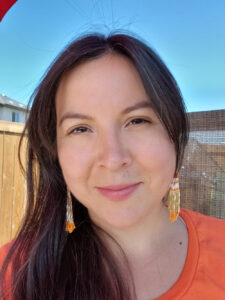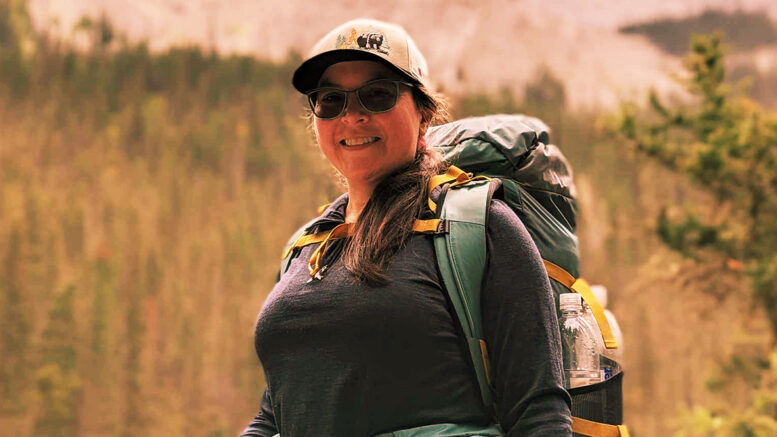By Laura Mushumanski, Local Journalism Initiative Reporter
(ANNews) – Have you ever noticed that around bodies of water there are large trees? These perennials have large taproot systems and without them there would not be a basin of water. “The taproots hold everything else together so we can have that body of water.” This becomes a sustainable life force within nature and the teaching transcends into worldviews coming together to support people to be well. This is the understanding that our Indigenous sister Tracy Atkin who walks in two worlds – non-Indigenous and Indigenous – came to and a way of knowing how to engage in the world around her.

Tracy Atkin
Atkin reflected on how she came to understand her role within community. “I loved experiencing [growing up in the bush on a rural acreage], being in nature and learning all things that I could from my parents at a young age. After my parents split up, it became more of a balance trying to navigate between two worlds.” This led Atkin to continuously try and find balance between the two worlds she walks in, “being my Indian self in some locations, and my white self in others … I was white passing to maintain safety that way.”
As Atkin got older, she tried to find out who she was, and while in university, she tried to balance psychology and Native Studies. She said, “My entire life I found myself jumping back and forth—I never really found a way to merge the two worlds, until recently.” Tracy went back to school for a master’s in clinical social work and found herself trying to merge learnings from the Western worldview and the Indigenous worldview. “I don’t think it is sustainable to be one or the other today.”
When speaking about sustainability as a way to understand and immerse herself within both Indigenous and Western worldviews, Atkin saw the reciprocal relationship between these worldviews. That relationship complements how she helps people stay well. “There are good learnings in [both Indigenous and Western worldviews]. In my work right now, I am focusing on merging those two worldviews to support people to be well. As I continue to do that, being really humble with recognizing that I don’t know everything, our cultures are so diverse…. We need to let the families and the people we support really lead that way, build our connection amongst each other and with the land—with nature, with our spirituality and just being open to seeing where that goes.”
Atkin’s vocation for supporting adults with acquired brain injuries started during her undergraduate studies when a loved one passed away tragically from a traumatic brain injury. “I had a really hard time focusing on my regular classes, so I ended up taking a lot of neuropsychology classes, some social work classes about grief and loss. This was the only way that I could focus … That led me into a career working with adults with acquired brain injuries, that got me into the agency that I still work with today—Taproot Community Support Services.” This is where Tracy has been leaning towards blending both worldviews for over 16 years.
The importance of learning and being open to learning has shaped Atkin in how she walks in her understanding of two worlds, rooted in understanding and honouring who she is as both an Anishinaabe and non-Indigenous woman. “I think this is where we get to blend a lot of learning—when we change behaviour, when we learn new behaviours or new ways of being. Those neuropathways are changing, and it is bringing up deeper rooted core beliefs and core learnings from our childhood or from our blood memory,” Atkin said. While she spoke about neuropathways being reorganized as an understanding of how overtime behaviours shift, she said that the healing work—the feeling of it being excruciatingly painful, “is not easy. It is painful… I remember being presented with some questions around if I am so rooted in my traditional beliefs and who I am, why don’t I speak the language. I started to try and learn Anishinaabe mowin—coming into this and developing that third sense of self, our authentic self. It is not easy because that brings up all these other things that are deep rooted in me like why didn’t I learn [the language] to begin with.”
Atkin’s life-long learning journey has shifted her own perspectives towards an understanding of how to not allow perceptions of people, places, and things undermine her self-worth and integrity by staying true to herself. “It is not just about learning a language, it is about overcoming a lot of the stigma, the emotions, even the family perceptions around it. I think this is going to be a lifelong process, it is a journey for me. I know that there have been times that I go off of my path and get sucked into work in the day to day and getting things done, and I forget to take that time to sit back and smudge and pray and connect with the land and just listen to Creator. When I make space for that, I think I feel like I get the strength to continue on and keep merging those worlds, being who I am and being comfortable with that.”
Atkin’s advice she would gift herself, “Stop being so scared and take a chance,” while acknowledging, “we need to take up space in those environments, so we are taking back control in some of that. There was a lot of self doubt as I was moving up in the company… Can I speak up? Is my voice valued? I am recognizing that I value my voice, and it is my responsibility to take up space in these environments – and trust in that journey.”



Be the first to comment on "Merging two worlds and keeping people well with Tracy Atkin"